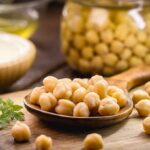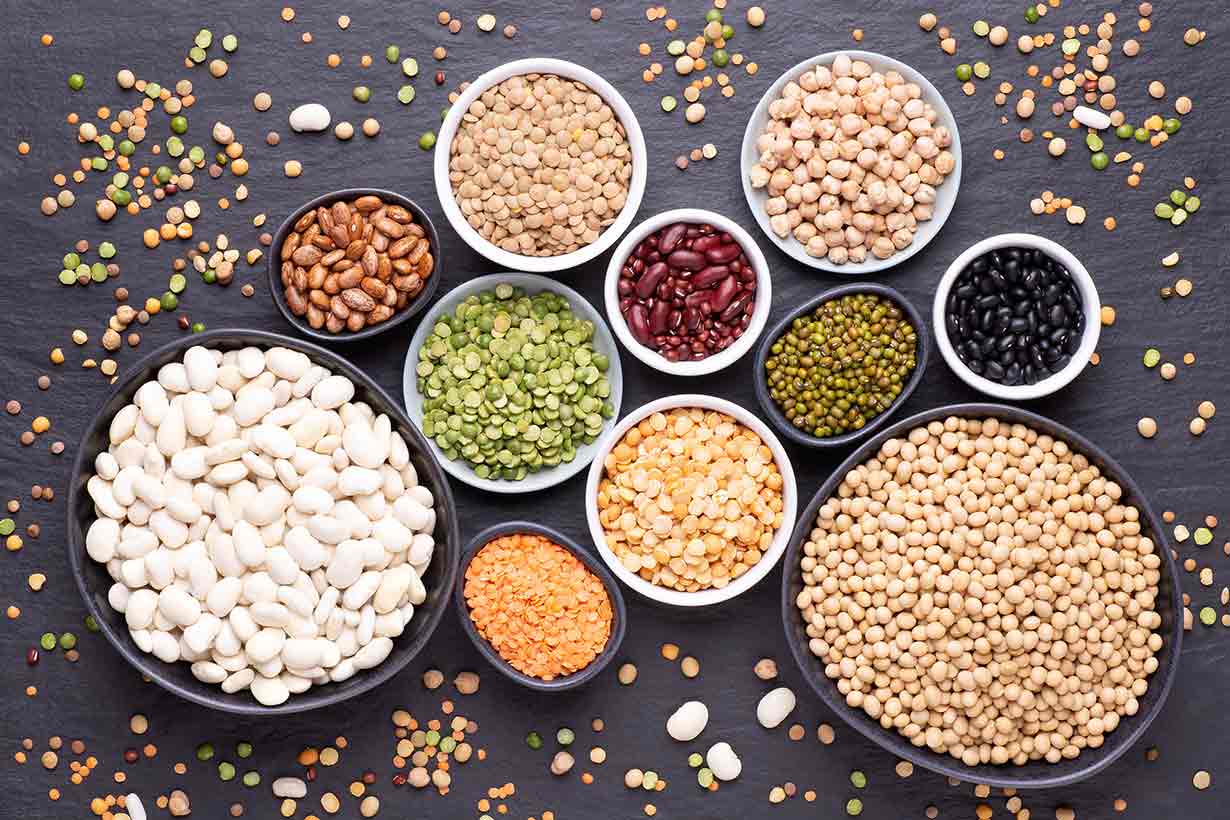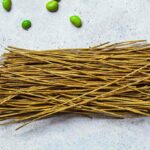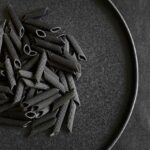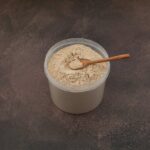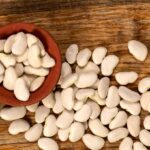Chickpea pasta is one of several legume-based pasta varieties to hit the market in recent years.
However, is it a good choice nutritionally? And how does it compare to regular pasta?
This article reviews chickpea pasta’s nutritional properties and potential benefits and downsides.
Table of contents
What Is Chickpea Pasta?

If regular pasta is pasta made from wheat, chickpea pasta is simply pasta made from chickpeas.
Making the product involves the following steps (1):
- First, chickpeas are ground into flour.
- Next, the chickpea flour is mixed with water and formed into a dough.
- The pasta mixture then goes through an extrusion machine, forming the pasta into shapes.
- After extrusion, the chickpea pasta undergoes a drying process.
- Once dry, the next step is the packaging process, and then the pasta is ready for distribution.
Chickpea pasta can be used in the same ways as regular pasta, and it is sold and marketed as a like-for-like alternative.
Ingredients
Like this product, most chickpea pasta should only contain one ingredient: chickpeas or chickpea flour.
However, it is possible to find some ‘chickpea pasta’ products that mix chickpeas with wheat flour or other ingredients. For example, this product is a mixture of chickpea flour, brown rice flour, and potato starch.
For genuine chickpea pasta, it is important to check the label ingredients to confirm the only ingredient is chickpea flour.
Taste and Texture
In terms of texture, chickpea pasta is similar to regular pasta, but it has a slightly coarser and grainier texture.
Regarding its taste characteristics, chickpea pasta has an earthier flavor than regular pasta alongside slightly nutty tones. It isn’t as mild as regular pasta, which could be seen as good or bad depending on one’s position.
However, it does taste like chickpeas, so people who enjoy the taste of chickpeas will probably like chickpea pasta.
What Nutrients Does It Contain?
Chickpea pasta provides a varied nutritional profile that is somewhat different from wheat pasta.
Nutrition Facts
The following tables show the full nutritional values of cooked chickpea pasta per 140-gram cup.
The data source for nutritional information is the NCC Food and Nutrient Database (2). All daily values (% DV) have been calculated using the nutritional data and the FDA’s published daily values (3).
| Name | Amount | % Daily Value |
|---|---|---|
| Calories | 185 kcal | |
| Carbohydrates | 28.25 g | 10.3% DV |
| Fiber | 4.54 g | 16.2% DV |
| Sugars | 4.62 g | |
| Fat | 2.83 g | 3.6% DV |
| Saturated | 0.30 g | 1.5% DV |
| Monounsaturated | 0.63 g | |
| Polyunsaturated | 1.26 g | |
| Omega-3 | 0.05 g | |
| Omega-6 | 1.21 g | |
| Protein | 11.38 g | 22.8% DV |
Vitamins
| Vitamin | Amount | % Daily Value |
|---|---|---|
| Choline | 35.47 mg | 6.4% DV |
| Folate | 179.48 mcg | 44.9% DV |
| Vitamin A | 1.36 mcg | 0.2% DV |
| Vitamin B1 (thiamin) | 0.20 mg | 16.7% DV |
| Vitamin B2 (riboflavin) | 0.04 mg | 3.1% DV |
| Vitamin B3 (niacin) | 0.72 mg | 4.5% DV |
| Vitamin B5 (pantothenic acid) | 0.25 mg | 5% DV |
| Vitamin B6 | 0.20 mg | 11.8% DV |
| Vitamin C | 0 mg | 0% DV |
| Vitamin D | 0 mcg | 0% DV |
| Vitamin E | 0.35 mg | 2.3% DV |
| Vitamin K | 4.73 mcg | 3.9% DV |
Minerals
| Mineral | Amount | % Daily Value |
|---|---|---|
| Calcium | 35.44 mg | 2.7% DV |
| Copper | 0.41 mg | 45.6% DV |
| Iron | 3.54 mg | 19.7% DV |
| Magnesium | 53.16 mg | 12.7% DV |
| Manganese | 0.72 mg | 31.3% DV |
| Phosphorus | 155.06 mg | 12.4% DV |
| Potassium | 452.18 mg | 9.6% DV |
| Selenium | 3.51 mcg | 6.4% DV |
| Sodium | 40.05 mg | 1.7% DV |
| Zinc | 1.24 mg | 11.3% DV |
Benefits of Chickpea Pasta
Here is a summary of some of the main benefits of chickpea pasta.
High In Protein
As with all legumes, chickpeas are relatively high in protein.
With 11.38 grams of protein per 140-gram cup serving, chickpea pasta offers a good protein source.
Adding cheese, meat, fish, tofu, or other protein can help turn it into a protein-rich meal.
Good Source of Fiber
Chickpea pasta provides high levels of dietary fiber.
On this note, a 140-gram cup offers 4.54 grams, which is 16.2% of the daily value (28 grams) (3).
Gluten-Free
Many people cannot consume gluten-containing foods due to an inflammatory autoimmune disorder called celiac disease. For people with this condition, the immune system overreacts to gluten, which leads to a range of symptoms caused by inflammation (4).
Since wheat is the primary dietary source of gluten, regular white pasta and wholewheat pasta are unsuitable for people following gluten-free diets.
Like edamame pasta and red lentil pasta, chickpea pasta contains no gluten and thus is suitable for gluten-free diets.
Products like chickpea pasta allow people with gluten sensitivity to enjoy a pasta-like experience free of gluten.
Note: as mentioned earlier, it is vital to check the ingredients of any pasta product to ensure it doesn’t contain additional ingredients, some of which may contain gluten.
Good Source of Vitamins and Minerals
As shown in the nutritional profile section, chickpea pasta provides a good range of essential vitamins and minerals, including:
- 179 mcg of folate, which is nearly half of the recommended daily value (400 mcg). Folate is an important nutrient for producing DNA, properly functioning cells and supporting healthy pregnancies (3, 5).
- 0.41 mg of copper, which is again nearly half of the recommended daily value (0.9 mg). Among its functions, copper is vital in energy production, the nervous system, and the immune system (3, 6).
- More than 10% of the daily value for thiamin, vitamin B6, iron, magnesium, manganese, phosphorus, and zinc.
As this shows, not only does chickpea pasta provide protein and fiber, but it also offers good levels of vitamins and minerals.
Lower In Calories Than Regular Pasta
Another benefit of chickpea pasta is that it has fewer calories than regular pasta. For example, a 140-gram cup of cooked chickpea pasta contains 185 calories, whereas the same amount of wheat pasta provides 221 calories (7).
This makes chickpea pasta a simple, beneficial alternative to regular pasta for people trying to lower their calorie intake.
How Does Chickpea Pasta Compare To Wheat Pasta?
Aside from the differences covered so far, chickpea pasta understandably has nutritional differences from wheat pasta.
In this section, we’ll examine some of these differences.
Nutritional Composition
Firstly, the following table will compare the complete nutritional values of chickpea pasta with enriched white pasta and wholewheat pasta.
All values are per 100 grams cooked, with nutritional data sourced from the NCC and USDA FoodData Central databases (2, 7, 8).
| Nutrient | Chickpea Pasta | White Pasta | Wholewheat Pasta |
|---|---|---|---|
| Calories | 132 kcal | 158 kcal | 149 kcal |
| Carbohydrates | 20.18 g | 30.9 g | 30.1 g |
| Fiber | 3.25 g | 1.8 g | 3.9 g |
| Sugars | 3.30 g | 0.56 g | 0.75 g |
| Fat | 2.02 g | 0.93 g | 1.71 g |
| Saturated fat | 0.21 g | 0.18 g | 0.24 mg |
| Monounsaturated fat | 0.45 g | 0.13 g | 0.18 mg |
| Polyunsaturated fat | 0.90 g | 0.33 g | 0.57 mg |
| Omega-3 | 0.04 g | 0.02 g | 0.04 g |
| Omega-6 | 0.86 g | 0.30 g | 0.54 g |
| Protein | 8.13 g | 5.80 g | 5.99 g |
| Choline | 25.33 mg | 6.4 mg | 6.5 mg |
| Folate, DFE | 128.20 mcg | 73 mcg | 21 mcg |
| Vitamin A, RAE | 0.97 mcg | 0 mcg | 0 mcg |
| Vitamin B1 | 0.14 mg | 0.27 mg | 0.16 mg |
| Vitamin B2 | 0.03 mg | 0.14 mg | 0.10 mg |
| Vitamin B3 | 0.52 mg | 1.69 mg | 3.13 mg |
| Vitamin B5 | 0.18 mg | 0.11 mg | 0.27 mg |
| Vitamin B6 | 0.14 mg | 0.05 g | 0.09 mg |
| Vitamin B12 | 0 mcg | 0 mcg | 0 mcg |
| Vitamin C | 0 mg | 0 mg | 0 mg |
| Vitamin D | 0 mcg | 0 mcg | 0 mcg |
| Vitamin E | 0.25 mg | 0.06 mg | 0.23 mg |
| Vitamin K | 3.38 mcg | 0.5 mcg | 0.6 mcg |
| Calcium | 25.32 mg | 7 mg | 13 mg |
| Copper | 0.29 mg | 0.1 mg | 0.23 mg |
| Iron | 2.53 mg | 1.28 mg | 1.72 mg |
| Magnesium | 37.97 mg | 18 mg | 54 mg |
| Manganese | 0.51 mg | 0.32 mg | 1.32 mg |
| Phosphorus | 110.76 mg | 58 mg | 127 mg |
| Potassium | 322.98 mg | 44 mg | 96 mg |
| Selenium | 2.51 mcg | 26.4 mcg | 36.3 mg |
| Sodium | 28.60 mg | 1 mg | 4 mg |
| Zinc | 0.89 mg | 0.51 mg | 1.34 mg |
Looking at the table, the comparison shows that:
- Chickpea pasta contains significantly lower calories and carbohydrates than wheat and wholewheat pasta.
- Chickpea pasta has almost double the fiber content of wheat pasta, gram-for-gram. However, wholewheat pasta contains slightly higher amounts.
- Out of the three pasta products, chickpea pasta has a higher protein content. It contains more than two grams more per 100 grams.
- Chickpea pasta generally provides higher amounts of each vitamin and mineral than regular wheat pasta. However, the gap is smaller when compared to wholewheat pasta. Chickpea pasta has significantly higher choline, folate, and potassium content. In contrast, wholewheat pasta has substantially higher levels of niacin (B3), manganese, and selenium.
Glycemic Index
The glycemic index is a scale designed to predict how much specific foods raise blood sugar levels compared to pure glucose (which has a rating of 100). For instance, a score of 100 would significantly impact blood sugar levels, whereas a score of 1 would be minimal (9, 10).
There do not appear to be any studies that tested the glycemic index of chickpea pasta. However, we do know the glycemic index of whole chickpeas.
According to the International Tables of Glycemic Index and Glycemic Load Values 2008, chickpeas have a glycemic index of 28 (11).
Additionally, a study entitled ‘Polyphenols and the glycaemic index of legume pasta’ published in 2019 looked at the glycemic index of a legume pasta product made from 60% grass pea flour and 40% chickpea flour. The glycemic index of this product was recorded as 23 (12).
This data shows that a pure chickpea pasta product would likely have a low glycemic index.
In contrast, according to the International Tables of Glycemic Index, regular wheat pasta (spaghetti) has a moderately higher glycemic index of 49 (11).
Downsides
There are no clear nutritional downsides to chickpea pasta. However, there are still some potential drawbacks:
Price
Chickpea pasta is not prohibitively expensive. However, it does consistently cost more than wheat-based pasta.
This extra expense is undoubtedly something to consider for people on a tight budget.
Potential (Rare) Allergies
Firstly, wheat is one of the nine major allergens, whereas chickpea allergy is comparatively uncommon (12).
In this context, chickpea pasta is at a lower risk for causing allergic reactions than wheat pasta.
That said, chickpea allergy is still an allergy often identified as the cause of severe allergic reactions, and there is little public knowledge of it (13, 14).
A recent 2020 study recently identified several proteins found within chickpeas as the allergens responsible for allergic reactions (15).
Anyone who suspects they may have a chickpea allergy should avoid chickpea pasta and other chickpea products and seek guidance from their medical team.
How To Use
Chickpea pasta can be used as a like-for-like replacement in recipes calling for wheat pasta.
Preparing this pasta is a very similar process too:
- Firstly, bring a pan of water to a boil; about 400 ml per 50 grams of dried chickpea pasta should be about right.
- Once the water is boiling, add the pasta to the pan and lower the heat.
- Simmer the pasta for approximately 5-7 minutes - use the shorter time for a firmer taste and the longer for a softer texture.
- Once ready, drain the water from the pan, and then the pasta is ready to use.
Common Questions
Here is some additional information on chickpea pasta designed to answer any common questions people might have.
The overall taste and texture experience between chickpea pasta and regular pasta is similar. However, there are clear differences between the two, and there will be a recognizable change in taste if swapping between the two. However, chickpea pasta tastes good and has a slightly stronger flavor with slightly nutty notes.
Some chickpea pasta contains only chickpeas, but this isn't always true. Therefore, it is important to check the ingredients of a product carefully to confirm whether this is the case.
Whether chickpea pasta is a better choice than wholewheat pasta really depends on what someone wants from their pasta. Both offer more nutritional value than white pasta, provide a good range of vitamins and minerals, and have distinct differences. Chickpea pasta may be the preference if lower calories or higher protein is a priority. On the other hand, wholewheat pasta offers more fiber on a gram-for-gram basis.
Yes, chickpea pasta is designed as a like-for-like alternative, and it can be used in any recipe calling for wheat pasta. However, it is worth noting that there will be some slight differences in flavor and texture.
Final Thoughts
Chickpea pasta is still a relatively new product on store shelves, but it should be a welcome addition for those who enjoy pasta.
It offers more protein, fiber, vitamins, and minerals for fewer calories than regular white pasta. This nutritional value makes chickpea pasta an excellent alternative for those who enjoy the taste.

